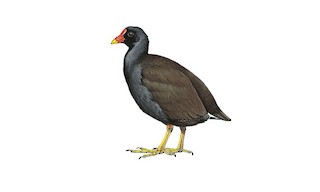
© Hilary Burn
Tristan Moorhen Gallinula nesiotis Scientific name definitions
- EX Extinct
- Names (23)
- Monotypic
Richard G. Littauer
Version: 2.0 — Published January 31, 2025
Revision Notes
Revision Notes
Sign in to see your badges
Species names in all available languages
| Language | Common name |
|---|---|
| Bulgarian | Тристанска зеленоножка |
| Catalan | polla de l'illa de Tristan da Cunha |
| Croatian | tristanska mlakuša |
| Czech | slípka tristanská |
| Dutch | Tristanwaterhoen |
| English | Tristan Moorhen |
| English (United States) | Tristan Moorhen |
| Estonian | tristan da cunha tait |
| Finnish | etelänliejukana |
| French | Gallinule de Tristan da Cunha |
| French (Canada) | Gallinule de Tristan da Cunha |
| German | Tristanteichhuhn |
| Japanese | トリスタンバン |
| Norwegian | tussoksivhøne |
| Polish | kokoszka atlantycka |
| Russian | Тристанская камышница |
| Serbian | Barska kokica sa ostrva Tristan (izumrla) |
| Slovak | sliepočka tristanská |
| Spanish | Gallineta de Tristan |
| Spanish (Spain) | Gallineta de Tristan |
| Swedish | tristanrörhöna |
| Turkish | Tristan Sutavuğu |
| Ukrainian | Курочка тристанська |
Revision Notes
Richard G. Littauer revised the account. Guy M. Kirwan and Alexander M. Bond reviewed the draft. Alexander M. Bond contributed to the Measurements section.
Gallinula nesiotis Sclater, 1861
PROTONYM:
Gallinula nesiotis
Sclater, 1861. Proceedings of the Zoological Society of London 1861, Part 2, p.261 pl.30.
TYPE LOCALITY:
Tristan da Cunha.
SOURCE:
Avibase, 2024
Definitions
- GALLINULA
- gallinula
- nesiotis
The Key to Scientific Names
Legend Overview
UPPERCASE: current genus
Uppercase first letter: generic synonym
● and ● See: generic homonyms
lowercase: species and subspecies
●: early names, variants, misspellings
‡: extinct
†: type species
Gr.: ancient Greek
L.: Latin
<: derived from
syn: synonym of
/: separates historical and modern geographic names
ex: based on
TL: type locality
OD: original diagnosis (genus) or original description (species)

- Year-round
- Migration
- Breeding
- Non-Breeding
Distribution of the Tristan Moorhen
Gray crosshatching represents former range. Map last updated 1 May 2024.





































